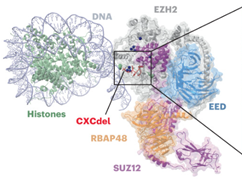In the context of cancer, “drug addiction” has a different meaning—counterintuitively, it’s when cancer cells, not patients, depend on continuous treatment for survival. This can happen if, after the drug target is inhibited, some compensatory signaling pathway is turned on that serves a similar function in the cancer cell. When drug treatment stops, the cell goes into “withdrawal” and this alternative pathway becomes overactive, so much so that it leads to cell death. In this way, drug addiction can reveal new vulnerabilities in cancer cells; a drug designed to overstimulate these alternative pathways could have the same lethal effect on cancer cells as treatment withdrawal.

At Harvard University, Damon Runyon-Rachleff Innovator Brian B. Liau, PhD, and his lab have set out to find such a drug for diffuse large B-cell lymphoma (DLBCL), an aggressive cancer of the lymphatic system. Lymphomas such as DLBCL arise from mutations in a protein complex known as PRC2, which controls gene expression by methylating, or “turning off,” certain genes. Mutations in PRC2 can cause tumor suppressor genes to get turned off, allowing the lymphoma cells to grow uncontrollably.
These cancers can be effectively treated with PRC2 inhibitors—except in cases where the lymphoma cells become addicted to the inhibitors. In these cases, the cells are able to maintain methylation levels (i.e., silence tumor suppressor genes) even in the presence of PRC2 inhibitors. But when PRC2 inhibitor treatment stops, the cells become overmethylated, repress too many genes, and die. Lymphoma cells, it appears, can only survive in a “Goldilocks” state of methylation: not too little and not too much.
Sensing a therapeutic opportunity here, Dr. Liau and his team investigated which PRC2 mutations confer drug addiction and, not surprisingly, zeroed in on a group of mutations that make PRC2 hyperactive. Cells with these mutations, the team reasoned, are too good at methylation for their own good, making them resistant to PRC2 inhibitors but susceptible to overmethylation. To test this hypothesis, they indirectly stimulated PRC2 by blocking a different protein. Sure enough, this triggered overmethylation, silenced too many genes, and stopped lymphoma cell growth.
Dr. Liau’s findings are exciting not only because they indicate a new therapeutic avenue for the treatment of lymphoma, but also because they show how cancer drug addiction can be leveraged to uncover and exploit new cancer cell weaknesses. And while “exploit,” “weakness,” and “drug addiction” do not normally belong in the same sentence, in the context of cancer, this is excellent news.
This research was published in Nature Chemical Biology.







